NEXT STORY

Something for Everyone: Working with German crews
RELATED STORIES

NEXT STORY

Something for Everyone: Working with German crews
RELATED STORIES



There was a very interesting other feature in that movie. And that is that we decided to erect quite a large set, on location in a field, in the vicinity of the castle, which was sort of weather covered. It wasn't entirely suitable as weather cover because if it rained there very heavily you could hear the rain. But they erected what's called an air hall which is like a large tent held up by air pressure, by pressurised air... compressed air. And, they laid a floor in this field, a wooden floor, so we could track throughout the set, which is built in this air hall, which, as I say, was quite large. Usually used for certain sporting events and exhibitions and things. And I would say that was very successful. I don't know whether anybody else ever did that, either before or after. I haven't heard of it. But it was fully described in the American Cinematographer at the time, with pictures and everything. And the... the two art directors, which were a couple called Otto and Herta Pischinger, they built this very elaborate set of a villa, in this air hall, and it was... it had two if not three storeys.
There was a big sweeping staircase that went up and rooms at the top, or at least entrances to rooms at the top. On the ground floor there were three... there were four rooms and a hallway. And the idea of building that all in one piece was that there was a tracking shot planned in the... in the middle of the film somewhere there was a tracking shot where, in a bit of a temper, the countess, which is played by... who was played by Angela Lansbury, she sweeps through these rooms and she throws opens the doors, and then she goes to the next room and then she throws open some more doors and goes on. So it was built in order that there could be a continuous track. In the end, of course, the track wasn't completely continuous because, every time she throws open the door, you have to cut anyway because you cut... you can't go through a closed door and then see it opening. So, there had to be a cut there anyway.
It was an elaborate effort and one of the rooms was a dining room, and that had quite a low, carved ceiling, and because we were shooting in the ratio of 1.66, wide-screen... The problem about wide-screen is that if your... if you emphasise the wideness and you forget the fact that the wider you go, what is implied in that is a lack of height. It's wide but it's very low, as far as height is concerned. So without being able to dig a floor... dig a hole in the floor, I couldn't actually get the setup, a reasonable setup, that would show this wonderful ceiling. I'm afraid they never forgave me for that, but they should've known better, because they knew about the format. They had all these projections with angles drawn on pieces of paper, and they should've known that it was virtually impossible to get a setup that would show the ceiling. I think corners of it come in, but not the whole thing. But the work in the air hall was extremely successful, and, as I say, it provided a sort of weather cover. Except when you had heavy rain, then you could hear it splattering on the canvas.
Born in Germany, cinematographer Walter Lassally (1926-2017) was best known for his Oscar-winning work on 'Zorba the Greek'. He was greatly respected in the film industry for his ability to take the best of his work in one area and apply it to another, from mainstream to international art films to documentary. He was associated with the Free Cinema movement in the 1950s, and the British New Wave in the early 1960s. In 1987 he published his autobiography called 'Itinerant Cameraman'.
Title: "Something for Everyone": The air hall
Listeners: Peter Bowen
Peter Bowen is a Canadian who came to Europe to study and never got round to heading back home. He did his undergraduate work at Carleton University (in Biology) in Ottawa, and then did graduate work at the University of Western Ontario (in Zoology). After completing his doctorate at Oxford (in the Department of Zoology), followed with a year of postdoc at the University of London, he moved to the University's newly-established Audio-Visual Centre (under the direction of Michael Clarke) where he spent four years in production (of primarily science programs) and began to teach film. In 1974 Bowden became Director of the new Audio-Visual Centre at the University of Warwick, which was then in the process of introducing film studies into the curriculum and where his interest in the academic study of film was promoted and encouraged by scholars such as Victor Perkins, Robin Wood, and Richard Dyer. In 1983, his partner and he moved to Greece, and the following year he began to teach for the University of Maryland (European Division), for which he has taught (and continues to teach) biology and film courses in Crete, Bosnia, and the Middle East.
Tags: American Cinematographer, Something for Everyone, Otto Pischinger, Herta Pischinger, Angela Lansbury
Duration: 3 minutes, 22 seconds
Date story recorded: June 2004
Date story went live: 24 January 2008